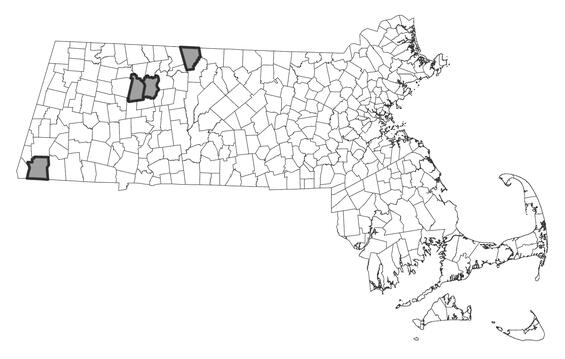- Scientific name: Hypericum ascyron
- Species of Greatest Conservation Need (MA State Wildlife Action Plan)
- Endangered (MA Endangered Species Act)
Description
Giant St. John’s-wort (Hypericum ascyron) is a tall herbaceous perennial wildflower of the St. John’s-wort family (Clusiaceae) that usually grows in alluvial soils within floodplain habitats. Plants are robust with multiple branches arising from stems that can grow up to 2 m (6.5 ft) in height. The sessile leaves are arranged opposite one another on stems. The large, conspicuous yellow flowers and the large conical-shaped fruits are the plant’s most recognizable features.
Giant St. John’s-wort emerges on stout stems give rise to compound branches. The sessile opposite leaves are lanceolate to elliptic in shape, 4 to10 cm (~ 1.5 to 4 in) long, and clasping at the base. The leaves and stems are often glaucous (covered with a whitish waxy bloom). The showy yellow flowers are borne on long pedicels at the ends of branches and have five large petals (25–30 mm [1-1.2 in] long), five smaller sepals, and a dense cluster of stamens united into five basal sets. The flowers have five united, spreading styles at the apex of fruit. As the flower matures the petals curl lengthwise into one another. The fruit is a distinctive pyramid-shaped capsule (15–30 mm [0.6-1.2 in] tall) with five chambers (locules).
When giant St. John’s-wort is found in flower in the appropriate habitat, the likelihood of confusing this plant with another species in its genus is small. However, if the plant is vegetative it is possible that it could be confused with plants with similar. One possibility is indian hemp (Apocynum cannabinum), though the opposite leaves of this plant are short-stalked and mucronate (tipped with a short, sharp, abrupt point), and its stems and leaves contain a milky sap.
Life cycle and behavior
This is a perennial species. Giant St. John’s-wort flowers in midsummer and fruits late summer into autumn.
Population status
Giant St. John’s-wort is listed under the Massachusetts Endangered Species Act (MESA) as endangered. All listed species under MESA are protected from killing, collecting, possessing, or sale and from activities that would destroy habitat and thus directly or indirectly cause mortality or disrupt critical behaviors. MassWildlife’s Natural Heritage & Endangered Species Program has 11 records from 3 counties: Berkshire, Franklin, and Hampshire. Six of these records have been observed within the last 25 years.
Distribution and abundance
Giant St. John’s-wort is known from eastern-central Canada (Ontario and Quebec) and possibly Manitoba, most of the New England States, south to West Virginia and into the Midwest as far west as Nebraska and Kansas. This species is sporadic and rare in all New England states.

Distribution in Massachusetts. 2000-2025. Based on records in the Natural Heritage Database.
Habitat
In Massachusetts, giant St. John’s-wort occupies habitats that are proximate to flowing water, including riverside ledges, cobble and gravel river shores, wet meadows, fields, moist thickets of streams and rivers, and power line rights-of-way. Populations tend to favor open areas. Associated species include a mix of herbaceous plants and vines such as late goldenrod (Solidago gigantea), rough-stemmed goldenrod (Solidago rugosa), stinging nettle (Urtica dioica), calico aster (Symphyotrichum lateriflorum), blue heart-leaf aster (Symphyotrichum cordifolium) and wild morning-glory (Calystegia sepium), groundnut (Apios americana), and wild cucumber (Echinocystis lobata). Possible woody associates include silver maple (Acer saccharinum), green ash (Fraxinus pennsylvanica), and silky dogwood (Swida amomum). The non-native herbaceous grass reed canary grass (Phalaris arundinacea), an invasive, is also sometimes associated with giant St. John’s-wort.
Healthy habitats are vital for supporting native wildlife and plants. Explore habitats and learn about conservation and restoration in Massachusetts.
Threats
Changes in flooding regime due to anthropogenic land use could elicit changes in habitat quality (e.g., less flooding could allow colonization by competing and over-shading woody plants).
Conservation
The exact management needs of giant St. John’s-wort are not known. As with all species, however, maintaining habitat quality is essential. Giant St. John’s-wort habitat should be monitored for invasive exotic species. Invasive plants can out-compete native plants for nutrients and block light, excluding them over time. Exotic species of concern in flood plain communities include common reed (Phragmites australis ssp. australis), garlic mustard (Alliaria petiolata), purple loosestrife (Lythrum salicaria), moneywort (Lysimachia nummularia), reed canary grass (Phalaris arundinacea), and Japanese knotweed (Fallopia japonica). If exotic plants are invading giant St. John’s-wort’s habitat, a plan for control should be constructed. All active management within the habitat of a rare plant population (including invasive species removal) is subject to review under MESA and should be planned in close consultation with MassWildlife’s Natural Heritage & Endangered Species Program.
Contact
| Date published: | April 29, 2025 |
|---|